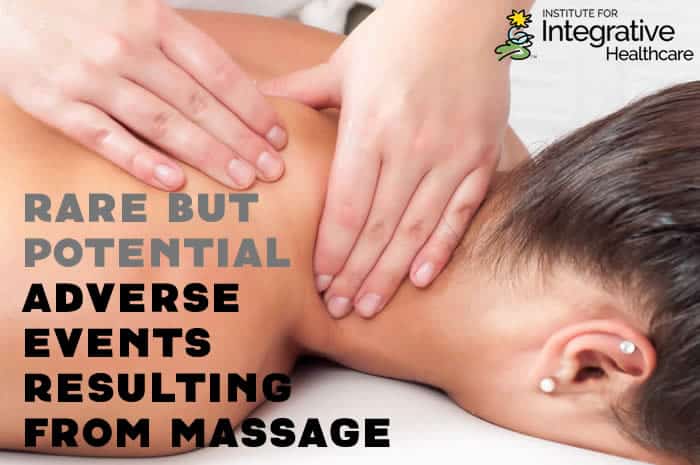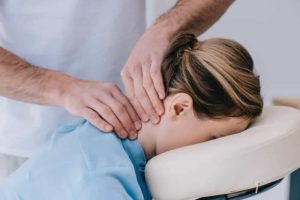

Short Lived Side Effects of Massage
Side effects, while not a usual feature of most massages, are generally mild and can include bruising, soreness, and fatigue (1). Most such symptoms start fewer than 12 hours after the massage and last 36 hours or fewer (2). In other words, the effects are short lived.
Adverse Events
Adverse events, in contrast, “are medium to long term, moderate to severe and unacceptable, [and] they normally require further treatment and are serious and distressing” (3).
However, understanding the literature on this topic is muddied, owing to the fact that the terms “side effects,” “adverse effects,” and “adverse events” are often used interchangeably without definition.
In fact, while the issue of patient safety incidents in manual therapies, including massage, has been garnering increased attention in the medical literature, such study “still suffers from a lack of uniform definitions of terms related to patient safety and events” (4, p. 113).
How often adverse events occur is also hard to determine.
Adverse events are most often documented in case reports, but not every adverse event is documented. For instance, if a lawsuit is involved, it’s often not even possible to write a case report. Some lawsuits do rise to the level of being newsworthy (5, 6).
But, more often, the details of a lawsuit end up remaining confidential. Although it is believed that the First Amendment gives the press and public the right to access court records (7), in practice, “busy district court judges will often then rubber stamp the parties’ motion [to seal the documents of a case] without further inquiry, thereby inadvertently disregarding the public’s presumptive right of access to court records” (8).
That said, most researchers believe that “serious adverse events are probably true rarities” (9). Rare or not, no massage therapist wants to hurt a client, so it’s important to be aware of what might lead to such an outcome.
A review of the literature reveals that not all reported adverse events are the result of massage by a licensed practitioner. In one instance, for example, a 59-year-old man was admitted to the hospital with a blood clot that had been released from his left kidney following a massage from his wife that included her walking on his back (9).
In another instance, a systematic review of adverse events resulting from therapeutic massage tabulates nearly 50 instances of such events, only three of which were known to have occurred in the context of work performed by trained massage therapists (10).
It is also worth noting that, in the majority of the cases mentioned in the latter review, “the problems were related to spinal manipulations, including rotational movements” (10), and spinal manipulation is outside the scope of practice for massage therapists and should therefore not be done during the course of a massage (11).
Is Neck Massage Safe?

Many massage therapists do, however, routinely perform massage on the neck. This is significant because a systematic review of the literature on the safety of massage reveals that most adverse events are associated with massage techniques applied to the neck area (12). In a number of reported cases, use of a massage tool for neck massage resulted in the dissection of the carotid artery (13, 14).
Manual neck massage has resulted in a number of serious events, including:
- artery dissection
- blood clots
- stroke (15, 16, 17, 18, 19)
- spinal cord injury (20, 21)
- nerve damage (22, 23)
- and hearing loss (9).
Both the anterior triangle of the neck—which includes the carotid artery, the jugular vein, and the vagus nerve that are deep to the sternocleiodomastoid muscles—and the posterior triangle of the neck—which includes the nerves of the brachial plexus, along with the brachiocephalic artery and vein superior to the clavicle and the subclavian arteries and vein—have long been known to be endangerment sites.
Textbooks such as Mosby’s Fundamentals of Therapeutic Massage do point out that “deep, sustained pressure in these areas can damage the vessels and nerves” but indicate that surface gliding with light pressure is permitted (24). Though techniques for working on the anterior and posterior neck are not (or at least should not be) in massage school curricula, those techniques are still sometimes taught, presumably with the injunction not to use a lot of pressure—though I did, alarmingly, find an NCTMB for clinical neck massage listed under the category “deep tissue techniques.”
Most of the time, that light pressure work on the sternocleiodomastoid and scalenes will be just fine. But is it really worth the risk?
At the very least, it seems like, ethically, the client should be informed of the potential consequences of doing work in those areas. A little bruising or soreness is one thing, but when the consequences could potentially be stroke, paralysis, or death, a client should have the right to make an informed decision.
Clearly, it is critical to check in with the client often during the massage if you do decide to work those areas and to listen to whatever feedback you’re given. When the client in one case expressed concern about the sudden pain in her neck, she was told it was simply because she was tense (18). But in fact, a week later, the woman had a stroke.
Adverse events from massage, of course, aren’t limited to neck and shoulder massage. In at least one case, massage caused nerve damage in the forearm of a client (25). And in an updated systematic review, Posadzki and Ernst found, in addition to cases of artery dissection, stroke, and so on, cases of “acute paraplegia and abdominal distension, bladder rupture, . . . cervical lymphocele [lymphatic fluid that has collected], . . . chylothorax [collection of fluid between the membranes lining the lungs], haematuria [blood in the urine], . . . myopathy, perinephric haemorrhage [bleeding in the kidneys], rhabdomyolysis [breakdown of skeletal muscle], severe headache, blurred vision, paraesthesia [tingling from peripheral nerve damage], and focal motor seizures” (12).
Conclusion
Nevertheless, it is worth repeating that Posadzki and Ernst conclude that serious adverse events were “most commonly associated with massage techniques applied to the neck area” (12), so it seems advisable to exercise particular caution when it comes to massage of that area, perhaps avoiding it altogether as a local contraindication or, at the very least using light pressure, as defined in pressure level 1 of the Walton Pressure Scale, meaning skin movement is only slight, with “little or no hand strength; no leaning with any weight of body; weight of arms/hands only” (26).











